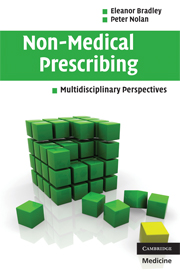Book contents
- Frontmatter
- Contents
- List of contributors
- Foreword
- Preface
- Acknowledgements
- Introduction
- 1 Medicines and prescribing – past and present
- 2 Nurse prescribing – impact, education and sustainability
- 3 Nurse prescribers: from 2003 to 2006
- 4 Nurse prescribing experienced
- 5 Nurse prescribing observed
- 6 Pharmacists and prescribing
- 7 Professions allied to medicine and prescribing
- 8 Conclusions
- Index
- References
7 - Professions allied to medicine and prescribing
Published online by Cambridge University Press: 22 August 2009
- Frontmatter
- Contents
- List of contributors
- Foreword
- Preface
- Acknowledgements
- Introduction
- 1 Medicines and prescribing – past and present
- 2 Nurse prescribing – impact, education and sustainability
- 3 Nurse prescribers: from 2003 to 2006
- 4 Nurse prescribing experienced
- 5 Nurse prescribing observed
- 6 Pharmacists and prescribing
- 7 Professions allied to medicine and prescribing
- 8 Conclusions
- Index
- References
Summary
Although ‘prescribing’ by non-medically qualified allied health professionals may reasonably be regarded as a recent development in the UK, it is also the case that a small number – most notably podiatrists, optometrists and ambulance paramedics – already enjoy an established history in the legal access, supply, administration and sale of certain restricted medicines (Borthwick, 2001a, 2001b, 2002, 2003, 2004; Borthwick & Nancarrow 2005; Lawrenson, 2005; Titcomb & Lawrenson, 2006). Other allied health professions (AHPs), such as physiotherapy and radiography, developed formal, legal rights to the administration and supply of medicines over a more recent timeframe (Hogg & Hogg, 2006). Across the AHPs, the use of medicines varies; in some cases ‘generalist’ practitioners may enjoy legal rights to administer, sell and supply restricted medicines, while in other cases it is confined to small numbers working within highly specialised fields (CSP, 1999).
In this chapter, the podiatry, optometry and ambulance paramedical professions serve as useful case exemplars of what might be referred to as early AHP ‘prescribing’, in the sense of having secured independent, legally acknowledged rights to the access, supply and administration of specific ‘prescription only’ and ‘pharmacy only’ medicines some time prior to the availability of ‘patient group directions’ (PGDs) and ‘supplementary’ prescribing. Radiography and physiotherapy are included as examples of AHPs that acquired such rights under PGDs and supplementary prescribing. Indeed, within the AHPs there has been a variable degree of interest in pursuing rights to access and administer medicines.
- Type
- Chapter
- Information
- Non-Medical PrescribingMultidisciplinary Perspectives, pp. 133 - 164Publisher: Cambridge University PressPrint publication year: 2008



